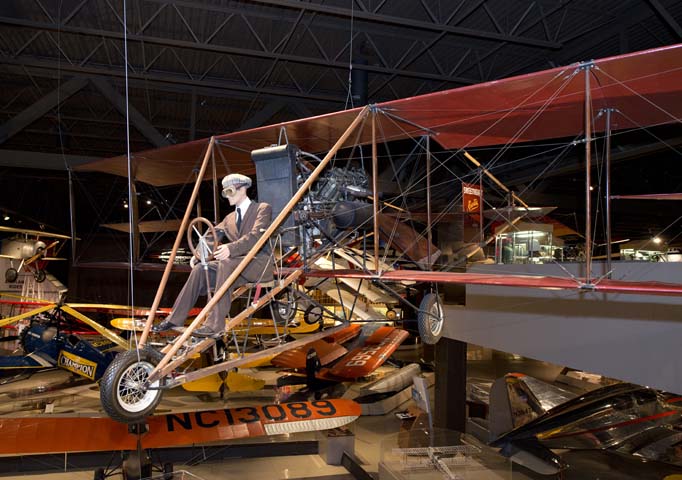1912 Curtiss A-1 Pusher 'Sweetheart' - N24034
Location: Pioneers of Flight
Built in the Glen H. Curtiss shops at Hammondsport, New York, in 1912, the Curtiss Pusher Model E-8-75 was shipped to San Diego, California, and used for pilot training at the Curtiss facility on Coronado Island. John Kaminski of Milwaukee, Wisconsin, a student at the flying school, bought the aircraft in May of 1912 and shipped it back to Wisconsin for exhibition use. John was the first licensed pilot in Wisconsin and was the one who nicknamed the Pusher Sweetheart.
In 1915, the Curtiss Pusher was sold to a blacksmith in Sullivan, Wisconsin, who used the engine on an iceboat, which later sank and was never recovered. The airframe was stored in a barn until discovered in 1940 by a CAA inspector named A. C. Goddard, who bought the remains. A restoration was started, but the task had not been completed when Goddard lost his life in an auto accident in 1956.
The aircraft’s remains were purchased from the Goddard estate by Dale Crites of Waukesha, Wisconsin, and, together with Earl Cox of Hartland, Wisconsin, a total rebuild was accomplished over a 10-year period. A 1918 Curtiss OX-5 engine was installed as a powerplant and on June 17, 1966, 53 years after the airplane had last flown, Dale Crites flew the Pusher with its unique yoke aileron control operated by the pilot’s shoulders.
The Curtiss Pusher used all-wood construction. The main fuselage poles were made of bamboo and balloon cloth fabric was stretched over the wings and tacked in place. The controls consisted of a combination of a wheel for rudder control, stick for elevator, a foot pedal for throttle, and a shoulder harness for ailerons. The original throttle pedal remains in front of the rudder bar, but a small lever type throttle attached to the seat actually controlled the power in the Pusher’s later years.
Numerous exhibition flights were made over several years in the 1960s until Dale Crites donated the Curtiss Pusher to the EAA AirVenture Museum in 1969. At that time, it was the oldest licensed airplane still flying in the United States. Now Sweetheart rests in the shadows of the Wright Flyer replica as part of a display in tribute to the first days of flight.
Length: 25 feet, 9 inches
Wingspan: 35 feet, 4 inches
Height: 8 feet
Empty Weight: 871 pounds
Gross Weight: 1,150 pounds
Crew: 1
Powerplant: Curtiss OX-5
Horsepower: 75
Maximum Speed: 60 mph
Cruise Speed: 50 mph




